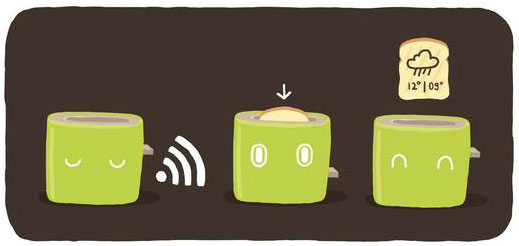
The Internet of Things is more than sassy appliances.
While the promise of Jetson’s like homes, with automated lighting, smart appliances, and voice command responsivity have been “on the horizon” since, well… since the days of The Jetsons (that's 1963, kids.) The average home contains very few of these high-tech "nesting" devices.
Etymology
The term “internet of things”, entered the zeitgeist 16 years ago. Each year since then has featured a flurry of products designed to connect our devices to the Internet, yet few of these products have become indispensable. The most noteworthy household IoT success doesn’t even measure data from home The Fitbit, for instance, measures and tracks the individual.
While the proliferation of smart appliances and networked homes has been cumbersome and disenchanting, the Internet of Things might be better understood as a revolution that will reshape industry long before it transforms the household.
In their report The Internet of Things: Mapping the value beyond the hype, the McKinsey Global Institute estimates that IoT will create 11 trillion dollars of value by the year 2025.
How?
The term Kaizen provides us with a useful antidote:
More than thirty years ago, Japanese auto-manufacturers, namely Toyota, had begun to surpass the quality and profitability of General Motors. In the early 1980s, John Shook got a job with Toyota so that he might learn what management and production techniques gave Toyota their competitive advantage. The most remarkable discovery was the culture of “kaizen”. Unlike the contentious environment of American manufacturing plants where management and laborers were at odds with each other, the Toyota plant had created a cooperative environment that continuously solicited and awarded employee feedback. If a line worker noticed an inefficiency or had a suggestion for improvement, the plant celebrated the idea and often implemented the changes on the very same day.
The Lesson is Here
An average manufacturing facility employs thousands of people. Toyota built their success upon the data and feedback of thousands of workers who vigilantly sought out improvement opportunities. Now, imagine; in a plant where there are twice as many machines as there are workers imagine if all those machines could provide feedback, even more, imagine if those machines could act and evolved according to their own feedback and data.
This is the frontier for the Internet of Things. Smart bearings, intelligent hydraulics, and insightful lasers.
While the benefits of connected household devices are marginal, the value created by smart industrial equipment will save and generate trillions in value over the next decade.
Smart Toilets
These and countless other industrial uses of the IoT will generate a third of the estimated $11 trillion value of the Internet of Things by 2025, according to a study by Mckinsey. But the impact of the IoT will be felt well before then. A study by research firm Gartner concluded that 43% of organizations are already using the IoT or are planning to implement IoT strategies within the year. Gartner also forecasts that 6.4 billion connected things will be in use worldwide by the end of 2016, with that number rising to 11.4 billion by 2018.
The fast-rising mountain of IoT data doesn’t exist in isolation. It all has to be stored and processed somewhere—on servers and storage devices in businesses, in the cloud, and, increasingly, in homes. That’s why all of those newly connected devices represent new vulnerabilities to data loss due to system failures, accidents, hackers, and viruses. And these vulnerabilities all boil down to one main risk factor: the possibility of crucial data becoming unavailable.
What happens when a wind farm is unable to adjust output in response to renewable energy prices going negative, something that can happen in a volatile energy market, like Californias? Or what about when, because of missing data, a plant manager’s smartphone can’t report that a motor on an industrial crane is about to burn out?
Fortunately, with robust backup solutions in place, nothing much—the interruption in the flow of data is minimal.
Backup Solutions
Strong backup solutions make data always available, no matter what, by protecting data on devices and servers and providing the means to seamlessly restore that data, if necessary. What’s more: such systems offer continuous accessibility and visibility by backing up critical data wherever it happens to reside—whether it’s in the cloud, on-premises, or in a hybrid of both.
Which is why backup is just as critical to the success of IoT-connected operations as the sensors, servers, and devices on the network. Backup keeps the river of data flowing, so that cranes can keep lifting; windmills keep spinning; workers stay safe, and yes, in ever-greater numbers, homes stay connected.
